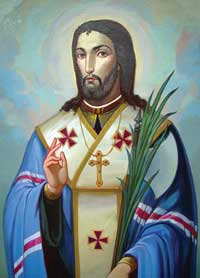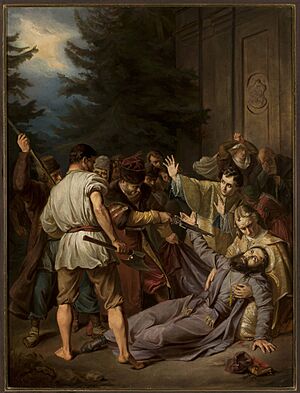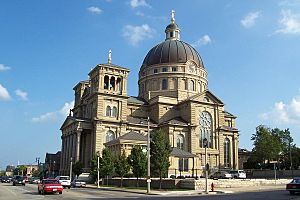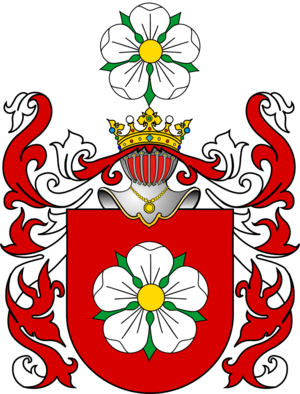Josaphat Kuntsevych facts for kids
Quick facts for kids Saint Josaphat Kuntsevych O.S.B.M. |
|
|---|---|
| Archeparch of Polotsk | |
 |
|
| Church | Ruthenian Uniate Church (present-day Ukrainian Greek Catholic Church) |
| Diocese | Archeparchy of Polotsk |
| Appointed | 1618 |
| Reign ended | November 12, 1623 |
| Predecessor | Gedeon Brolnitskyj |
| Successor | Antonius Sielava |
| Orders | |
| Ordination | 1609 |
| Consecration | 12 November 1617 by Archeparch Gedeon Brolnitskyj |
| Personal details | |
| Birth name | Ivan Kunchych |
| Born | c. 1580 Volodymyr, Volhynian Voivodeship, Polish–Lithuanian Commonwealth |
| Died | November 12, 1623 Vitebsk, Vitebsk Voivodeship, Polish–Lithuanian Commonwealth |
| Coat of arms | |
| Sainthood | |
| Feast day | November 12 (Latin Church, Belarusian Greek Catholic Church, Romanian Greek Catholic Church, Ruthenian Catholic Church) November 14 (General Roman Calendar of 1960) |
| Title as Saint | Bishop and martyr |
| Beatified | May 16, 1643 Rome by Pope Urban VIII |
| Canonized | June 29, 1867 Rome by Pope Pius IX |
| Patronage | [Ukraine]The St Leonards academy |
Josaphat Kuntsevych, a Basilian monk-priest and archbishop, lived from about 1580 to 1623. He was part of the Ruthenian Uniate Church, now known as the Ukrainian Greek Catholic Church. On November 12, 1623, he was killed during a riot in Vitebsk, a city in the Polish–Lithuanian Commonwealth. This event happened because of strong disagreements between Eastern Orthodox Christians and Eastern Catholics.
His death shows the tension between the Eastern Orthodox Church and the Eastern Catholic Churches. This tension grew after some bishops from the Ruthenian Orthodox Church joined the Catholic Church in 1596. This agreement was called the Union of Brest. Archbishop Josaphat was known for accepting and spreading Eastern Catholicism. He was made a saint and a martyr by Pope Pius IX in 1867.
Some people called Josaphat "The Soul-Snatcher" because he helped so many people convert to Catholicism. His biographer, Fr. Demetrius Wysochansky, wrote that Josaphat's work led many in Polotsk to become Catholic. He believed that many Catholics in Lithuania and Belarus owe their faith to Josaphat's efforts.
Josaphat Kuntsevych's Life Story
Understanding the Religious Background
King Sigismund III Vasa of the Polish–Lithuanian Commonwealth wanted to unite all Christians under the Catholic Church. He aimed to do this by sending missionaries to Protestants and Orthodox Christians. In 1595, some Eastern Orthodox bishops from the Kiev region went to Rome. They agreed to the Union of Brest in 1596. This meant they joined the Catholic Church but kept their own rituals.
This union caused a big split. Some bishops signed the agreement, while others did not. Those who signed became "Uniates" or Eastern Catholics. This term is now considered offensive by some. These Eastern Catholics were often seen as "traitors" by those who remained Orthodox. By 1620, about two-thirds of the Ruthenian population had become Greek-Catholics.
Those who did not sign the Union remained Eastern Orthodox. They were sometimes called "Disuniates" or "dissidents." They faced some unfair treatment from the government. They did not have official leaders until a new Eastern Orthodox leadership was set up in 1620. The government officially recognized this new group in 1632.
Josaphat's Early Life and Education
Josaphat was born Ioann Kuntsevych around 1580 or 1584. He was born in Volodymyr, a city now in Ukraine. His family was Eastern Orthodox.
His family was from the Ruthenian nobility, but his father was a town councilor and businessman. Josaphat's parents encouraged him to be religious. At school, he showed great talent. He studied Church Slavonic and memorized much of the Horologion, a prayer book. This book was a key part of his early religious learning.
Because his parents were not rich, Josaphat became an apprentice to a merchant in Vilnius. Vilnius was a city with many different religious groups. There, he met people like Josyf Veliamyn Rutsky. Rutsky was a former Calvinist who became Catholic and joined the Byzantine Rite. Rutsky supported the union with Rome. Under his influence, Josaphat became very interested in the Catholic Church.
Becoming a Monk and "Soul-Snatcher"
In 1604, when he was in his early 20s, Josaphat joined the Monastery of the Trinity in Vilnius. He took the religious name Josaphat. He tried to live like the early Christian monks. He prayed the Jesus Prayer constantly, even in his sleep. He also practiced strict self-discipline. For example, he would pray all night in the cemetery during winter, wearing light clothes. He offered his suffering for the salvation of others.
Stories of the young monk's holiness spread quickly. Many important people visited the monastery to ask for his spiritual advice. Many young men also joined the monastery because of Josaphat's reputation. Josaphat believed that the Union of Brest was a return to the true Christian traditions of the East. He was very good at explaining this idea and convincing Orthodox Christians and Calvinists to become Eastern Catholics. Because of this, his opponents called him "The soul-snatcher."
During the process to make him a saint, a city councilman named Dorotheus Akhrymovych testified. He said that parents at first complained about Josaphat "snatching" their sons. But later, they were happy with the results and thanked him.
Another priest, Father Gennadius Khmelnytsky, said that Josaphat was called "Soul-snatcher" because he converted so many people. He even said that a painting in an Orthodox church showed Josaphat as a devil dragging souls to hell. Below the painting, it said: "Soul-snatcher."
However, when Josaphat heard this name, he would smile. He would say, "God grant me the grace to snatch all your souls and lead them to Heaven."
In 1607, Rutsky, who had been a layman, also joined the same religious order.
Josaphat as a Priest and Archbishop
Josaphat became a deacon and began serving the Church regularly. Because of his efforts, more and more new monks joined the order. Under Rutsky, who had become a priest, Eastern Catholic monastic life began to grow again. In 1609, Josaphat was ordained a priest by a Greek Catholic bishop.
Joseph Velamin-Rutski later said that Josaphat cared for prisoners until their last moments. He would hear their confessions and go with them to their execution. He did this gladly, even at inconvenient times like evening or winter.
Josaphat later became the hegumen (head) of several monasteries. He was known for giving generously to the poor, widows, and orphans. When he left to become Archbishop of Polotsk, beggars cried because they were losing their helper. His kindness grew even more as an archbishop. People said his palace was like a market for beggars.
On November 12, 1617, he became the assistant archbishop for the Archeparchy of Polotsk. He became the main archbishop in March 1618. During his time as archbishop, the Saint Sophia Cathedral in Polotsk was rebuilt between 1618 and 1620.
Josaphat faced the big challenge of getting people to accept the union with Rome. He faced strong opposition from monks and priests who did not want changes. As archbishop, he worked to restore churches. He gave a catechism (religious teaching guide) to his clergy and made rules for priests. He held meetings in different towns and stood firm against those who wanted to make too many compromises with the Eastern Orthodox. He continued his strict spiritual practices, offering his sufferings for the conversion of others. Through all this, he successfully won over many people.
However, discontent grew in the eastern regions. In 1618, an Orthodox nobleman in Mohilev resisted the union. He replaced Greek Catholic priests with Orthodox ones. This led to government action against the local Orthodox. A court order in 1619 sentenced the leaders to death and gave all Orthodox church buildings in Mohilev to the Ruthenian Catholic Church.
Some historians claim that Josaphat was not a man of peace. They say he was involved in unfair actions, like not allowing Orthodox peasants to bury their dead in Catholic cemeteries.
The Ruthenian Orthodox Church did not disappear. In 1620, they met in Kiev and chose new Eastern Orthodox bishops. These bishops were secretly consecrated by a visiting patriarch from Jerusalem. This created a rival Orthodox leadership. King Sigismund III accused the patriarch of being a secret agent for the Ottoman Empire. He ordered the arrest of the patriarch and the newly consecrated bishops.
After 1620, fighting over church property increased. Many clergy on both sides died in these conflicts. The government finally brought peace in 1632. They made the Orthodox leadership legal and divided church property between Catholics and Orthodox.
Josaphat's Death

In October 1623, Josaphat ordered the arrest of a priest. This priest was secretly holding Orthodox services in Vitebsk, where Josaphat lived. Angered by this, some Orthodox townspeople killed Josaphat on November 12.
In January 1624, a group investigated Josaphat's murder. They sentenced 93 people to death for their part in the plot. Many others were banished, and their property was taken away. The town hall and Orthodox churches were destroyed. The city's special rights were taken away, but later restored. After Josaphat's death, the Orthodox group in Lithuania was largely broken up. Their leaders were severely punished. They lost their churches in several cities.
Josaphat's body was found in the river and displayed in the cathedral in Polotsk. He was declared "blessed" in 1643. But he was not made a saint until 1867, more than two centuries later. His body is now in Saint Peter's Basilica in Rome.
Josaphat Kuntsevych's Legacy
Stories of His Holiness
As a boy, Josaphat was said to avoid typical childhood games. He prayed a lot and always went to church services. Children especially liked him. As an apprentice, he spent all his free time praying and studying. His boss, Papovič, at first didn't like this. But Josaphat eventually earned his respect. Papovič even offered him his entire fortune and his daughter's hand in marriage. But Josaphat always wanted to live a religious life.
Josaphat's favorite prayer practice was making prostrations. This is when you touch your head to the ground while saying the Jesus Prayer. He never ate meat and fasted often. He wore a hair shirt and a chain around his waist. He slept on the bare floor and disciplined his body. Jesuits often told him to ease up on his strict practices.
Josaphat studied Church Slavonic Byzantine Rite prayer books very carefully. From these, he found many proofs for Catholic teachings and wrote his own works. Throughout his life, he was known for his great devotion during church services. He preached and heard confessions not only in church but also in fields, hospitals, and prisons. This strong devotion, combined with his kindness to the poor, led many Eastern Orthodox people to convert to Eastern Catholicism. Among his converts were important figures like the former Patriarch Ignatius of Moscow.
Becoming a Saint
| Saint Josaphat O.S.B.M. |
|
|---|---|
 |
|
| Archeparch of Polotsk, Hieromartyr | |
| Born |
c. 1580 Volodymyr, Volhynian Voivodeship, Polish–Lithuanian Commonwealth |
| Died | November 12, 1623 Vitebsk, Vitebsk Voivodeship, Polish–Lithuanian Commonwealth |
| Venerated in | Catholic Church |
| Feast |
|
| Patronage | Ukraine |
After many miracles were said to happen because of Josaphat, Pope Urban VIII started an investigation in 1628. They interviewed 116 witnesses. It was also claimed that Josaphat's body was found to be incorrupt (not decayed) five years after his death. In 1643, Josaphat was declared "blessed." He was officially made a saint on June 29, 1867, by Pope Pius IX.
The Ukrainian Greek Catholic Church celebrates his feast day on the first Sunday after November 12 (Julian Calendar). In the Roman Catholic Church, his feast day is November 12.
Josaphat's process to become a saint began during a time of rebellion against the Russian Empire. Many people saw his sainthood as a sign of support from the Pope for the Polish rebels. Some Russian-leaning newspapers published negative articles about Josaphat. They suggested he was murdered because of his own actions, not as a martyr. The Russian government reacted by increasing efforts to make people more Russian. They also forced the last Eastern Catholic region in the Russian Empire to convert to Orthodoxy in 1875.
Honoring Saint Josaphat

According to The Oxford Dictionary of Saints, Josaphat Kuntsevych can be seen as a patron for efforts to bring different Christian groups together today.
Churches Named After Him
Saint Josaphat Kuntsevych is the patron saint of many Polish and Ukrainian churches in the United States and Canada. These include:
- The Basilica of St. Josaphat in Milwaukee, Wisconsin.
- St. Josaphat Ukrainian Catholic Cathedral in Parma, Ohio.
- St. Josaphat Roman Catholic Church in Chicago, Illinois.
- St. Josaphat's Parish in Bayside, Queens, New York.
- St. Josaphat's Ukrainian Catholic Church in Rochester, NY.
- St. Josaphat's Roman Catholic Church in Detroit.
- St. Josaphat Parish in Cheektowaga, New York.
- St. Josaphat's Cathedral and Ukrainian elementary school in Toronto.
- St. Josaphat Ukrainian Catholic Cathedral in Edmonton, Alberta.
- St. Josaphat Ukrainian Catholic Church of Trenton, NJ.
In Croatia, he is the patron saint of parishes in Rajevo Selo and Sibinj.
Society of St. Josaphat
In the 1990s, a group of Eastern Catholic priests and people formed the Priestly Society of Saint Josaphat. They had survived religious persecution by the Soviet government. They protested against what they saw as modern changes in the Ukrainian Greek Catholic Church. This group is connected to the Society of St. Pius X, which is critical of the Second Vatican Council.
Relics of the Saint
- A relic (a holy object connected to a saint) of Saint Josaphat is in the "catacombs" of Holy Trinity Roman Catholic Church in Chicago.
- There are two relics of Saint Josaphat in the Basilica of St. Josaphat in Milwaukee, Wisconsin. One is in the High Altar, and the other is in the lower Chapel. Documents from the Vatican confirm these relics are real.
See also
- Blessed Josaphata Hordashevska - Founder of the Sisters Servants of Mary Immaculate
- List of Catholic saints
- Saint Josaphat Kuntsevych, patron saint archive



